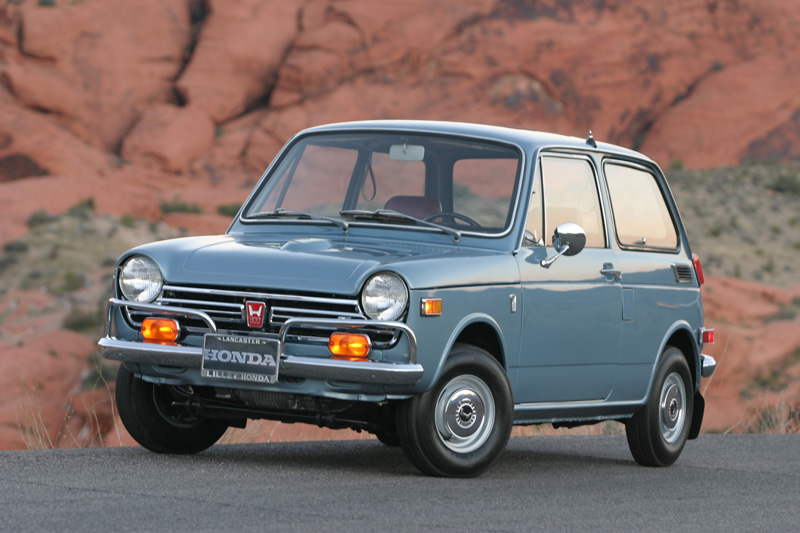
I bought an Ampex AM/FM cassette tape deck from where I was working with plans of getting some tunes during my commute. The dash on this tiny car was too small to house the stereo so I bolted it to the underside of the dash and built a box for some 4" speakers in the rear deck. That was 1972 and by this time the quality of cassette tapes had caught up to 8-track tapes. It didn't sound like music, not by any stretch of your imagination, but it did make noise and entertained me during my commute.
Cassette tapes were introduced in 1964 and they sounded horrible with huge tape hiss and no high frequency response, zero, zip, nada. It took 8 years for them to begin to sound reasonable and it wasn't until Nakamichi came along until they could be considered a high-end component. In 1973 Nakamichi broke the mold and introduced the first three-head cassette deck, the model 1000.

It was absolutely huge in physical size with a correspondingly high price ($1,300), but it was the first of many steps to improve this promising technology. The final version of this behemoth was created in 1981 (8 years later) and called the 1000ZXL Limited fetching $6,000 at your favorite high-end audio salon. Holding true to the fundamental concept of a no-holds-barred design, it retained its physical size and astounding performance.
Nakamichi's best product was probably the 680ZX, introduced in 1979, that truly solved many of the problems recording at a tape speed of under two inches per second. They did it so well that this particular model offered an even slower tape speed of just under one inch per second while still offering reasonably high-end performance.

It took about 15 years for Nakamichi to finally solve the problems associated with cassette tapes and pull all of the potential out that this media had to offer. Granted it still had its limitations but what it replaced (8-track tapes) never solved its own inherent limitations despite twice the tape speed. I still, have a 680ZX deck but unfortunately it is down right now in search of the switch PC board (donations anyone?) on the RH side.
1982 was a pivotal year in audio when a partnership between Philips and Sony introduced digital recording and the compact disc (the CD). Sony's CDP-101 was the debut player on the market and if you don't remember what this player sounded like, think of fingernails on a chalkboard.
When I heard this God-awful terrible sounding unit, I remembered how long it took for the finest minds in audio to figure out how to make cassette tapes sound good and I figured it would take at least that long to make this format sound like music. I wasn't far off, but it took a little longer than I had hoped.
CD players first struggled with the brick wall anti-aliasing filter, and then sampling frequency, and then clock jitter, and then A/D converters, and then...well, you get the picture. What was thought to be "perfect sound" at the time was indeed far from it. Huge obstacles had to be overcome (and I do mean HUGE) until the sound coming from these units even began to approach reality. But today, a mere 30 years later, CD players are at the level where the 680ZX was for the cassette tape. Unfortunately, it took twice as long to get there.
I'm sure you can name your own personal favorite player and who knows what next year will bring? But what is most promising is the higher bit words and higher sampling frequencies available today. The 24/96 and higher formats are now entering the high-end arena just as the cassette tape did back in 1964. I truly hope that the refinement of this technology does not take another 15 or 30 years to solve. I would like to hear real music coming from ones and zeros one day before I die.
Yours for higher fidelity,
Philip Rastocny
I do not use ads in this blog to help support my efforts. If you like what you are reading, please remember to reciprocate, My newest title is called Where, oh Where did the Star of Bethlehem Go? It’s an astronomer’s look at what this celestial object may have been, who the "Wise Men" were, and where they came from. Written in an investigative journalism style, it targets one star that has never been considered before and builds a solid case for its candidacy.
- Althea: A Story of Love
- Build an Extreme Green Composter
- The Extreem Green Guide to Wind Turbines
- Build and Extreme Green Hot Water Solar Collector
- The Extreme Green Guide to Solar Electricity
- The Extreme Green Guide to Improving Mileage
- Meditation for Geeks (and other left-brained people)
- Build an Extreme Green Raised Bed Garden
- Build an Extreme Green Rain Barrel
- Build an Extreme Green Squirrel-Proof Bird Feeder
- Extreme Audio 1: House Wiring
- Extreme Audio 2: Line Filtering
- Extreme Audio 3: Chassis Leakage
- Extreme Audio 4: Interconnect Cables
- Extreme Audio 5: Speaker Wires
- Extreme Green Organic Gardening
- Extreme Green Organic Gardening 2012
- The Extreme Green Appliance Buying Guide



No comments:
Post a Comment
To comment on this blog, you must first be a member. All comments are moderated.
Note: Only a member of this blog may post a comment.